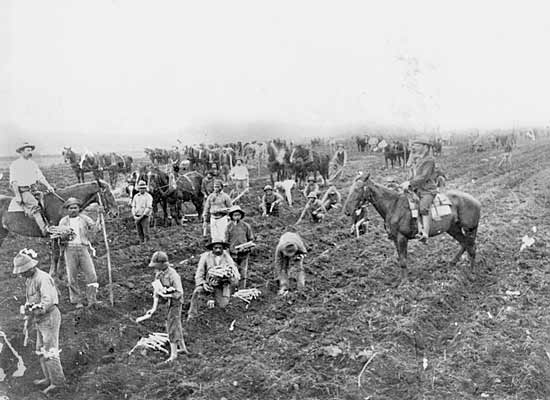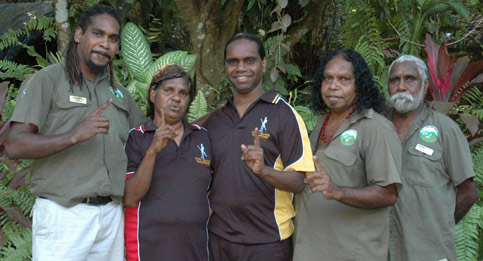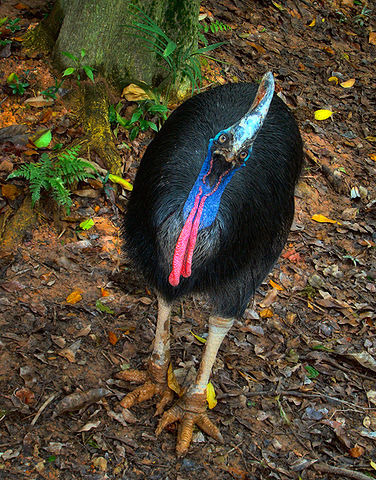Another day, another World Heritage Area. Today we headed through the Queensland sugar plantations to the rainforests of the Kuku Yalanji people. The experience was a direct clash between destructive but highly productive Western agriculture and indigenous no-growth stewardship of the land. For two centuries, this has been a history of the former defeating the latter. The Yalanji have been here for 40,000 years, though, so this little story is just a blip. What we saw was the contradiction between “globalization” and the planetary.
It was during the American Civil War that Queensland jumped into the business of sugar cane production to meet the fall in supply. Sugar cane was an immensely labor-intensive process and so indigenous labor from across the Pacific was brought in under compulsion.
Missionaries had no hesitation in calling it slavery (above). As a self-governing colony (until 1901), Queensland nonetheless had a free hand. The compeled labor was brought in from relatively close locations like ni-Vanuatu and the Solomon Islands and as far away as Polynesia. They were called “blackbirds,” and are still trying to get their story recognized.
In more recent times, the industry declined until the rise in demand for ethanol led to a massive revival. Although the cane growing is now highly mechanized, the square plantations of seven foot high plants, each as thick as a large finger, would be recognizable to any plantation owner or worker.
As ever, the grass (sugar cane is a grass) is visibly destructive. The crop rapidly denudes the soil because the indigenous tropical flora, although spectacular, are evolved to grow in the poor, sandy soil. Later we were shown a tree in the forest from whose seeds the Yalanji make bread. It’s eight hundred years old and only about twelve feet high. Sugar cane seedlings that I saw were therefore surrounded by black compost and white chemical powders. In between the fields, which are in all stages of production from planting to recently harvested, stand a few remnants of the forest.
Higher up, where the cane can’t grow, the rainforest and its people survive, protected now as a National Park and a UNESCO heritage site. Today the steep green slopes were shrouded in mist and cloud, looking more like Aotearoa New Zealand than the Sunshine State. The Kuku Yalanji people have recently begun to offer guided tours of their land and its culture.
Our walk, guided by Jenny, also known as Butterfly, was beautiful and informative. Apparently uninteresting plants were revealed to be means of cleaning, healing, or sources of food. Shelters were left for others to use, rather than being demolished. Few now live in this traditional way, but there’s a commitment to remembering and passing on the old ways. It’s easy to be naive and romanticize this way of life. But as Raymond (Kija/Moon) emphasized at the end of our tour, these people have survived in this place for millennia without rendering it unusable, as Europeans have managed in a couple of centuries.
Raymond performed the digeridoo for us, and showed the required technique of circular breathing, also used by some jazz players like Rahsaan Roland Kirk and Wynton Marsalis. Accompanying himself with clapsticks, he gave a virtuoso performance, imitating the sounds of numerous animals above the drone-like beat. He also insisted that the instrument was forbidden to women, although there are many known instances to the contrary. It seems to be another instance where a reaction against European culture is producing a more conservative form of indigenous culture. For example, art works that were formerly permitted by Elders to be seen in galleries have recently been reclassified as secret.
It’s hard to be censorious. The cassowary bird is a key link in the rainforest ecosystem.
It eats fruits that are poisonous to humans and disseminates the seeds in its scat. Humans have now taken to feeding the flightless bird. The cassowary becomes accustomed to being fed and sometimes attacks people for food. Human food has altered its digestive system, so we were told, with the result that it is less able to digest the fruits it normally eats. It’s at these small intersections that things go out of joint and violence results.
If it’s a direct choice between sugar culture and indigenous conservation, it’s seems clear where we should go. But it isn’t. The Kuku Yalanji are not proposing that kind of return to a lost beginning, in part because the land could no longer support the numbers of people that there are here, and in part because electricity, health care and other such modern conveniences are not worth revoking. There are some people living traditionally off the coast of the island of Kauai, part of the Hawai’ian archipelago, it should be said, and traditional navigation is making a return across the Pacific. By the same token, we can’t choose modern-style growth as a solution because there aren’t enough resources for everyone to live in the Anglo-US-Australian way. This is the sharpest edge between the myth of “globalization” and the actual experience of the planetary. All the choices are bad.



